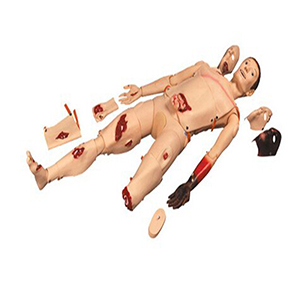In the first aid scene, trauma patients often face life-threatening situations, and the timely response and accurate operation of medical personnel are crucial. However, when performing trauma first aid under pressure, operational errors and errors in judgment are risks that cannot be ignored. In order to help medical personnel improve their first aid skills, advanced trauma model, as a highly simulated training tool, has become a key assistant to reduce clinical trauma first aid errors.
1. High simulation training to improve operational proficiency

The advanced trauma model uses a design that is very close to the real human body and can simulate various trauma scenarios, such as traumatic bleeding, fractures, and airway obstruction. By using this simulator, paramedics can practice each step of trauma first aid over and over again without actual risk. The highly simulated design allows students to feel real operational feedback, such as simulating real tissue responses during pressure hemostatic, and simulating real respiratory conditions during airway management. Through repeated practice, medical staff can become more skilled in dealing with real trauma patients and reduce errors caused by unskilled operation.
2. Real-time feedback to correct errors in time
The advanced trauma model is equipped with a real-time feedback system that provides immediate feedback on the effects of the operation as the trainee performs it. For example, during trauma first aid, if the hemostasis method is not appropriate or the depth of chest external compression is not enough, the model will show the corresponding vital signs changes in time, such as changes in blood pressure or heart rate fluctuations. This real-time feedback helps students immediately identify and correct errors, avoiding the serious consequences of incorrect first aid operations in practice. Studies have shown that training using this real-time feedback system can significantly improve students' operational accuracy and reduce clinical errors.
3. Multi-scenario simulation to enhance emergency response ability
The scene of trauma first aid is ever-changing, and the patient's injury condition may change rapidly, so the medical staff need to make quick judgment and response. The advanced trauma model can simulate a variety of trauma types, such as car accidents, gunshot wounds, internal bleeding and other complex situations, and help students adapt to different first-aid scenarios. In these simulated emergency environments, medical personnel can be trained to quickly make sound judgments and adjust first aid plans. This multi-scenario training can help students not panic when faced with complex cases, thus effectively reducing the mistakes that may occur in real first aid.
4. Teamwork and communication to improve overall efficiency
Trauma first aid often requires the collaboration of multiple medical personnel, especially in high-pressure first aid environments, coordination and communication between team members is critical. The advanced trauma model supports multi-person training, and students can play different roles during the simulation, such as emergency physicians, nurses, ambulance personnel, and so on. Through this simulation training, team members can familiarize themselves with each other's division of labor, improve communication efficiency and collaboration ability, and thus reduce medical errors caused by miscommunication.
5. Reduce mistakes and improve the success rate of first aid
Taken together, repeated training using advanced trauma models not only improves the accuracy of technical operations, but also enhances clinical decision-making and reduces errors caused by nervousness or inexperience. The study showed that health care workers who participated in the simulation training had a reduction of about 30% in the error rate when faced with real trauma first aid. This means that through the training of advanced trauma models, medical staff can perform first aid with more confidence and accuracy, thereby increasing the success rate of first aid and ensuring that patients receive the best treatment.
Conclusion
Advanced Trauma models help healthcare professionals train repeatedly in a risk-free environment, improve first aid skills, and reduce medical errors through high simulation design, real-time feedback, and multi-scenario simulation. This training not only improves operational accuracy, but also enhances emergency response and team collaboration, thus greatly reducing the occurrence of errors in clinical trauma first aid. For medical personnel, this simulation training is an important tool to improve the success rate of first aid and ensure the safety of patients.
